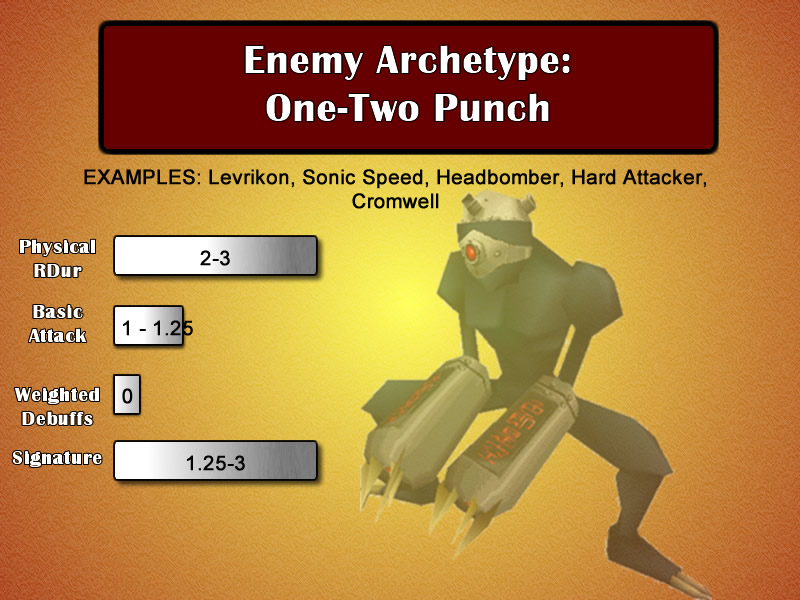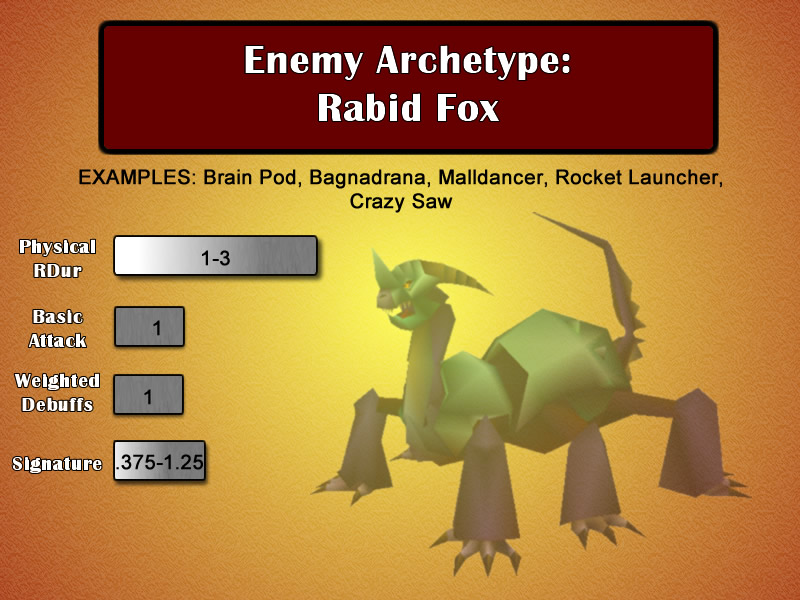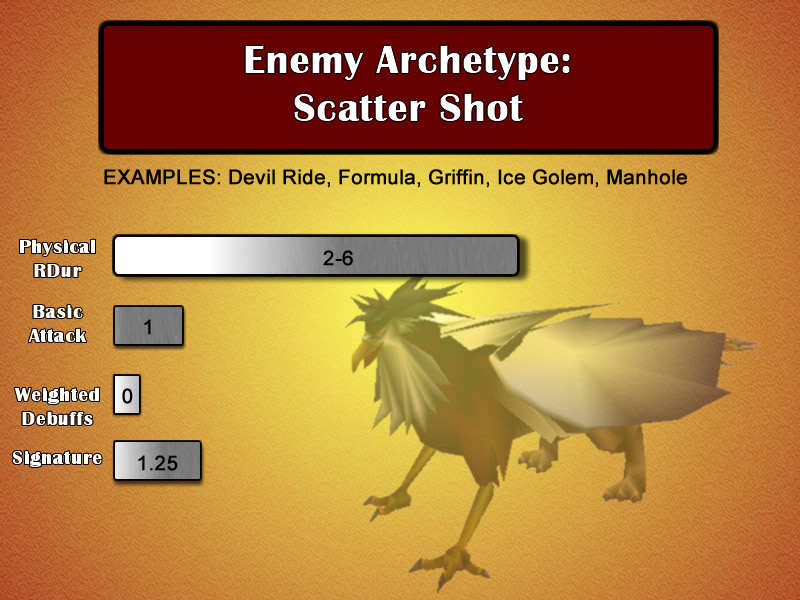Enemy Archetypes in FF7
Having seen all the phases and what they offer, I want to try reverse-engineering some design templates for non-boss enemies in FF7. The graphs in the previous sections only provide averages for each stat in a quest. Averages are useful for understanding what a whole quest is like in aggregate, but they don’t always explain how individual enemies contribute toward the overall feel of each battle, quest or the game at large. At the same time, it wouldn’t be useful to describe every individual enemy as a piece of unique content, because there’s too much noise in that. Instead, I’ve derived six archetypes of enemies found in FF7. These archetypes cover about two-thirds of all the non-boss battles in the game. There are some enemies which don’t fit into any category. Some of these enemies are gimmicky, like the Ying & Yang, Mover or Magic Pot enemies, who all have highly unusual abilities or defenses. Some of these enemies are extreme versions of game design concepts, like the Bomb and Grenade, who keep getting more dangerous throughout the fight. Some enemies are in place only to be hunted, like the Beach Plug. But the majority of FF7 enemies fall into some kind of archetype.
The One-Two Punch
The most basic enemy archetype is what I call the “one-two punch” type (OTP for short), and so I will use this type to explain how the template works. The first thing to notice is the behavior summary. The basic design idea behind the OTP is that it has a normal attack that does base damage, but it also uses a second ability—a special attack that does 1.25 to 3 times base damage. I call this ability the “signature” attack or ability, as it is the thing which defines most of the archetypes. The OTP tends to use its basic attack and signature attack interchangeably.

[90][91][92][93] [N.B. every archetype in this section is derived from these same sources]
The rest of the card is fairly simple. The top row shows the number of basic attacks required to defeat this enemy by Red XIII at the same level with the appropriate gear. Like everything else on the card, this row has a range of values, because not every enemy of an archetype is exactly the same. Note that although the range is displayed in highest-to-lowest order, that’s not necessarily chronological. As we saw in the discussions of phases two and three, different monster attributes peak at different times. The range simply covers the quests up until the final dungeon and optional content. The next row shows the component stat for the enemy’s basic attack, which is the most common attack all enemies use. Sometimes the basic attack is magical, but most of the time it’s physical. Sometimes an enemy’s basic attack is below base damage—it has a component stat of less than one—but usually it’s one or higher. The next row on the card shows the range of component stats for the OTP’s special ability, which is between one and three. Note that although the high-end for a special ability of the OTP is a component stat of three, this actually happens in phase three, not in phase four. On the other hand, the enemy with the highest component stat for this category (the Sculpture from the Whirlwind Maze) also has a low-end durability score of two. The enemy with the highest durability from this group is from the Northern Crater.
The Rabid Fox
Another simple type of enemy is the rabid fox family of enemies, which inflict the majority of the game’s debuffs. The typical setup for the rabid fox is that it has a basic attack which it mixes interchangeably with a signature attack that also inflicts a debuff.

Note that the signature ability still does damage. In phases one and two, the component stats for the debuff-inflicting abilities are below one, but by the end of the game these abilities grow to the point where they are even with (or sometimes slightly above) base damage. Interestingly, the basic attack for these creatures does not grow, and instead stays locked at base damage levels. Typically, the rabid fox type of enemy inflicts debuffs to which I gave a ranking of “1”—debuffs like poison, slow, frog and blind. Finally, although it isn’t listed on the card, I want to point out a trend in the AI of these enemies. Most enemies of this type use their debuff ability as part of a random mix of abilities that includes their basic attack. Sometimes, however, enemies of this type will continuously use their debuff ability until all party members are afflicted, even if this is an impossible goal because some party members are immune.
The Scatter-Shot
The scatter-shot type is built around a medium-low-strength attack which hits all party members. The component stat for this signature attack is almost always around 1.25. The most common durability score for these enemies is three normal attacks by an appropriately leveled and equipped Red XIII. The durability of this type of enemy varies a lot across the game, sometimes high and sometimes low, irrespective of how late in the game this enemy appears.

The up-and-down fluctuation in difficulty which is the bedrock of videogame design appears frequently in FF7, and the design of this enemy across the game is another example of that. Finally, the basic attacks for this type of enemy usually only do base damage.
The Magic Imp
Want to read more? The rest of this section can be found in the print and eBook versions.
Examining Wide Levels - Back | Next - Music and Design